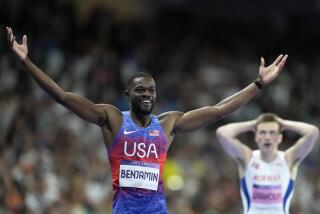Pedal to the medal?
- Share via
It is called individual pursuit.
Two bicyclists hunker down at opposite points of an oval indoor track and start racing.
A women’s race is 3,000 meters, 1.8 miles. The winner either chases down her opponent or clocks the best time on the course and moves on to the next round.
Over the past three years, the winner has often been Sarah Hammer, a quiet woman from Temecula who found fulfillment in road cycling, then frustration and now supreme satisfaction in track racing, the part of cycling where Lance Armstrong never won world renown or where Floyd Landis never gained infamy.
Hammer, 24, will be a favorite at the Los Angeles Track World Cup, which begins Friday at the Home Depot Center in Carson.
She is tentatively rediscovering her best form after being confounded by a lingering back injury that hampered her all of last season and into the first two races of this season.
She tried to keep quiet the fact that her back was bothering her during a race last month over the Beijing track where the Olympics will be held, but when the two-time world champion won only a bronze medal the rumors were confirmed.
“Right now, fingers crossed, the back is fine,” Hammer said. “I plan on it staying that way.”
Here is the 5-foot-7, 135-pound cyclist describing her event and why she loves it so:
“The first half lap to lap you’re just trying to get it up to speed as fast as possible, trying to get on top of that gear.
“You sit down coming into that first lap and start putting on power, just driving it. With the pursuit, the misconception is that it’s paced and steady. It’s not.
“The point is to get on top of the speed and hold on for dear life. Usually when I finish one of my championship rides I can’t get off the bike by myself. My legs are so locked up because I was holding on for dear life.”
In the spring of 2006, Hammer won the world championship of individual pursuit, becoming the first U.S. track world champion in 11 years. Five months after that, Hammer stomped on an 11-year-old national record held by Rebecca Twigg by riding the pursuit in a time of 3 minutes 32.865 seconds. Twigg’s record had been 3:36.08.
And Hammer defended her world pursuit championship in 2007, the first American to win back-to-back titles since Twigg in 1985 and ’86.
“Those were exciting results for us,” said Pat McDonough, director of athletics for USA Cycling. “It sent a buzz throughout the world really. Sarah’s story is pretty amazing.”
Hammer’s father, Cliff, had been a masters road racer in the South Bay and Sarah said she loved going to races to watch him.
When Hammer was 9 she started competing in road racing, the type of cycling seen at the Tour de France. When she was 14, Hammer tried her legs on an indoor track.
“Sarah was always driven,” Cliff said, “and from the first time she got on a bike she could push incredible power through those pedals. Nothing was ever an experiment with Sarah. She went out and did it. Period.”
Since her father never raced indoors, Hammer had plenty to learn. “We were so new we didn’t even know how to change gears, so I rode with the gear I had on,” she recalled. “We went down to the velodrome in San Diego. The track is a little intimidating at first, but once you get used to it there’s nothing like it. It’s just the adrenaline rush. When I was 15 I decided I wanted to go to the Olympics.”
McDonough said Hammer was “incredibly gifted” on the track and made an immediate impression on national coaches and international racers.
“She always had the look of an Olympic podium contender,” McDonough said.
When she was 18, Hammer got wanderlust and decided to try road racing again.
“I had so much success on the track . . . with no training I was winning races at nationals,” she said. “I stopped and thought about it and it seemed like a waste of time. So I switched to road racing.”
But, after a couple of years, she found the travel schedule for road races grueling and other aspects “disappointing.” While she wouldn’t say whether the culture of doping in road racing played a part in her decision to quit, Hammer did say that in track cycling, “There’s not much temptation to cheat. I mean, for what reason? It’s not the money.”
On the day she quit, Hammer said she got rid of her bikes, her gear, her cycling clothing. “ I wanted to get rid of it all,” she said. “I was hawking everything off on EBay -- clothes, gear, helmets, anything bike-related.
“It was burnout, pure and simple. I had been racing for so long. I think I just needed to live life a little bit differently. I was just ready to be a 20-year-old.”
To support herself, Hammer sold cellphones, worked at a bagel shop in Colorado Springs, where she lived with boyfriend and coach Andy Sparks, and as a waitress.
She watched the 2004 Olympics on television and at the end of the Athens Games she turned to Sparks, a former cyclist himself, and said, “I want to go back on the track,” not knowing what his reaction would be.
Sparks said his reaction was pure joy. “I always knew she would come back,” Sparks said. “I told her it was time for her to win the Olympics.”
Less than two years later, Hammer was breaking records and Sparks’ high aim doesn’t seem off the mark.
McDonough said that Hammer has a “hunger” for competition. He also said that Australia’s Katie Mactier, who won the last World Cup race in Beijing, did some boasting to the international media that may be taped to Hammer’s bulletin board.
Hammer doesn’t have a large team behind her. Sparks is the coach. Brent Kay, the San Diego doctor who performed hip replacement surgery on Landis, is the financial backer of her team, Ouch Cycling. Felt Bicycles, based in Irvine, is designing Hammer’s Olympic bike. That’s about it.
“I’m not doing this for the money,” Hammer said. “As long as I can survive. I’m not making 100 grand or anything. But that shouldn’t be anyone’s motivation.
“The driving force is to compete at the Olympics. To medal or win? That’s what drives me. Not what I can get afterward.”
--
More to Read
Go beyond the scoreboard
Get the latest on L.A.'s teams in the daily Sports Report newsletter.
You may occasionally receive promotional content from the Los Angeles Times.






